2021 YAMAHA FX SVHO warning
[x] Cancel search: warningPage 55 of 116
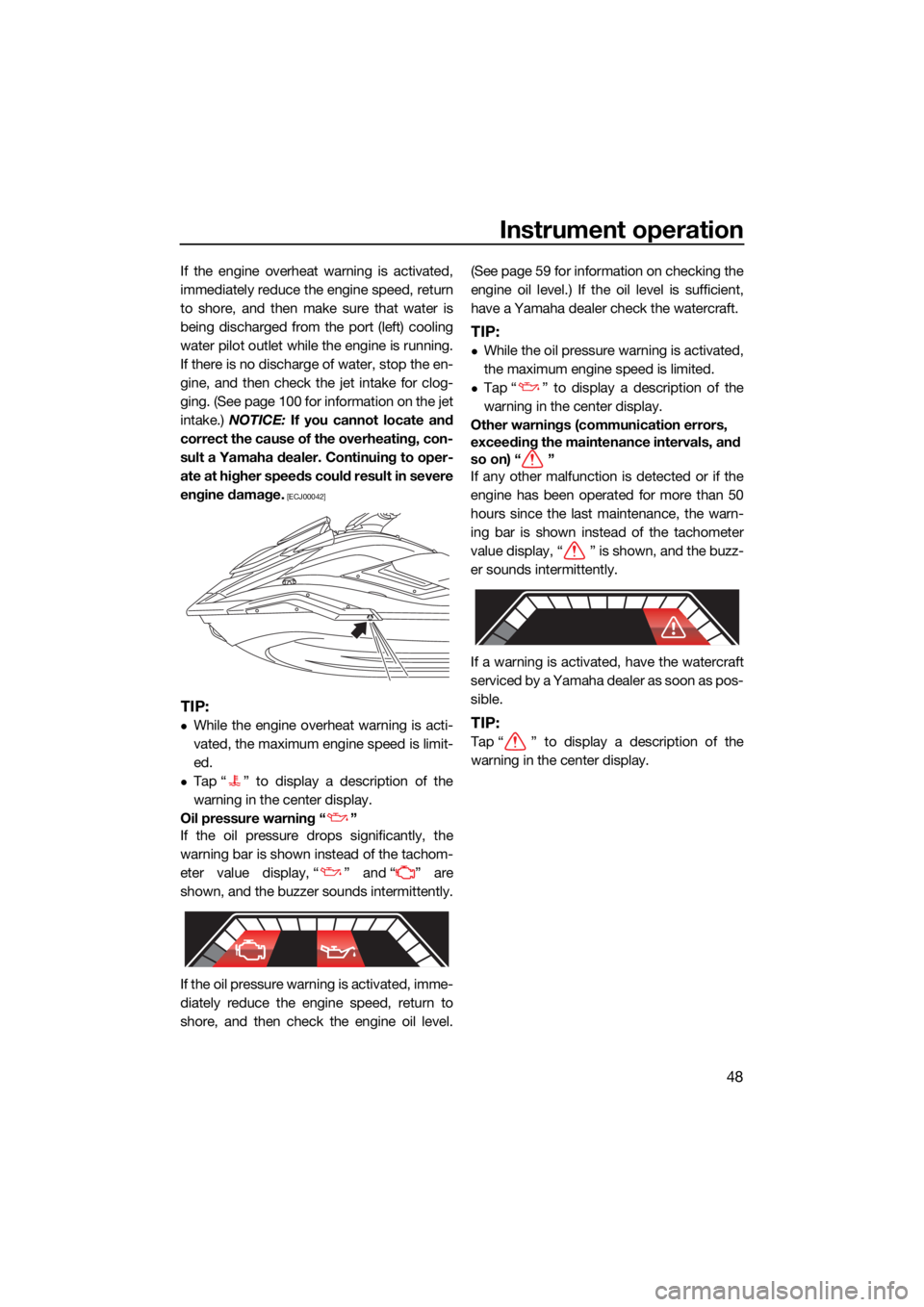
Instrument operation
48
If the engine overheat warning is activated,
immediately reduce the engine speed, return
to shore, and then make sure that water is
being discharged from the port (left) cooling
water pilot outlet while the engine is running.
If there is no discharge of water, stop the en-
gine, and then check the jet intake for clog-
ging. (See page 100 for information on the jet
intake.) NOTICE: If you cannot locate and
correct the cause of the overheating, con-
sult a Yamaha dealer. Continuing to oper-
ate at higher speeds could result in severe
engine damage.
[ECJ00042]
TIP:
While the engine overheat warning is acti-
vated, the maximum engine speed is limit-
ed.
Tap “ ” to display a description of the
warning in the center display.
Oil pressure warning “ ”
If the oil pressure drops significantly, the
warning bar is shown instead of the tachom-
eter value display, “ ” and “ ” are
shown, and the buzzer sounds intermittently.
If the oil pressure warning is activated, imme-
diately reduce the engine speed, return to
shore, and then check the engine oil level. (See page 59 for information on checking the
engine oil level.) If the oil level is sufficient,
have a Yamaha dealer check the watercraft.
TIP:
While the oil pressure warning is activated,
the maximum engine speed is limited.
Tap “ ” to display a description of the
warning in the center display.
Other warnings (communication errors,
exceeding the maintenance intervals, and
so on) “ ”
If any other malfunction is detected or if the
engine has been operated for more than 50
hours since the last maintenance, the warn-
ing bar is shown instead of the tachometer
value display, “ ” is shown, and the buzz-
er sounds intermittently.
If a warning is activated, have the watercraft
serviced by a Yamaha dealer as soon as pos-
sible.
TIP:
Tap “ ” to display a description of the
warning in the center display.
UF3X72E0.book Page 48 Friday, May 29, 2020 10:09 AM
Page 57 of 116
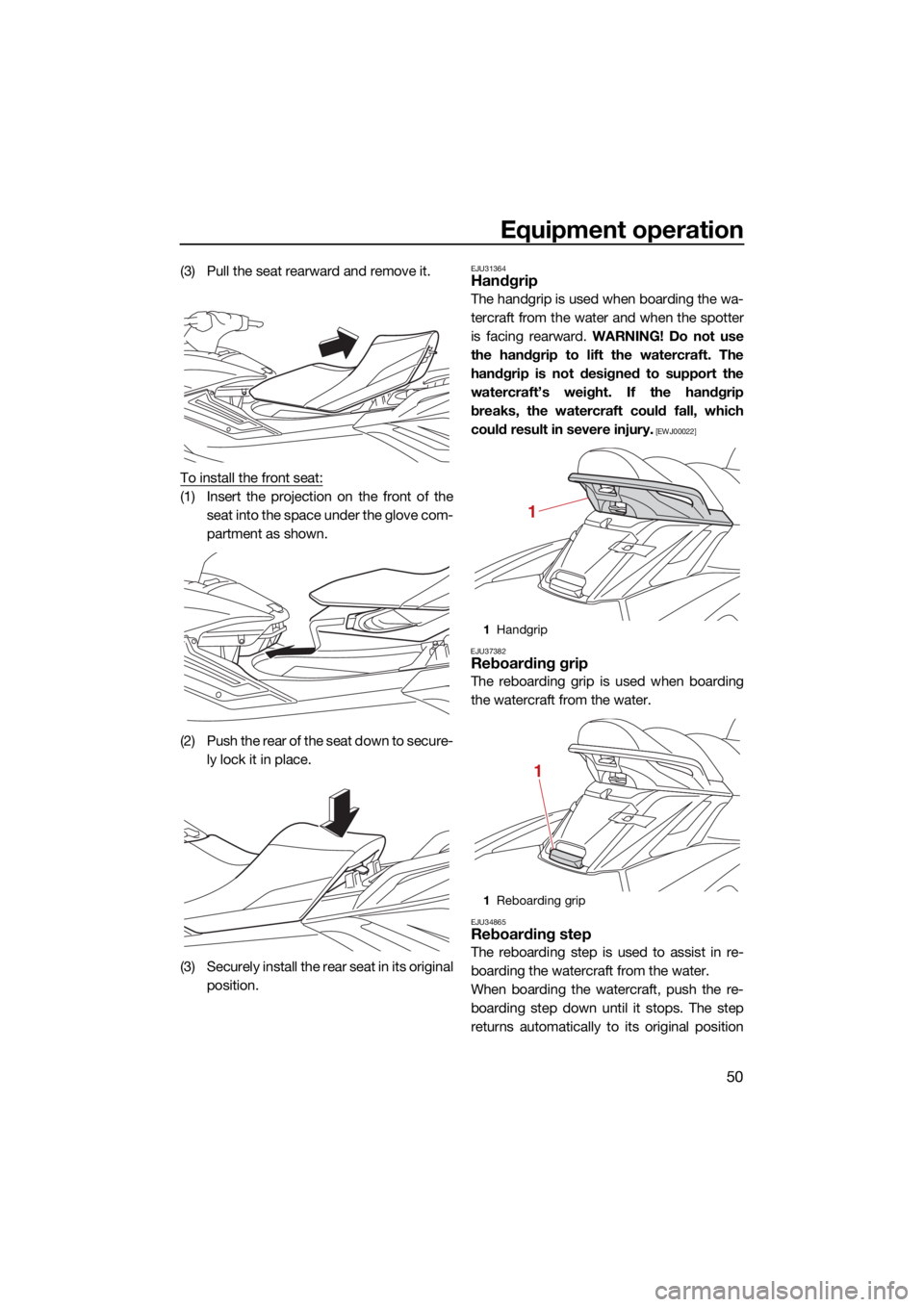
Equipment operation
50
(3) Pull the seat rearward and remove it.
To install the front seat:
(1) Insert the projection on the front of theseat into the space under the glove com-
partment as shown.
(2) Push the rear of the seat down to secure- ly lock it in place.
(3) Securely install the rear seat in its original position.
EJU31364Handgrip
The handgrip is used when boarding the wa-
tercraft from the water and when the spotter
is facing rearward. WARNING! Do not use
the handgrip to lift the watercraft. The
handgrip is not designed to support the
watercraft’s weight. If the handgrip
breaks, the watercraft could fall, which
could result in severe injury.
[EWJ00022]
EJU37382
Reboarding grip
The reboarding grip is used when boarding
the watercraft from the water.
EJU34865Reboarding step
The reboarding step is used to assist in re-
boarding the watercraft from the water.
When boarding the watercraft, push the re-
boarding step down until it stops. The step
returns automatically to its original position
1Handgrip
1 Reboarding grip
1
1
UF3X72E0.book Page 50 Friday, May 29, 2020 10:09 AM
Page 58 of 116
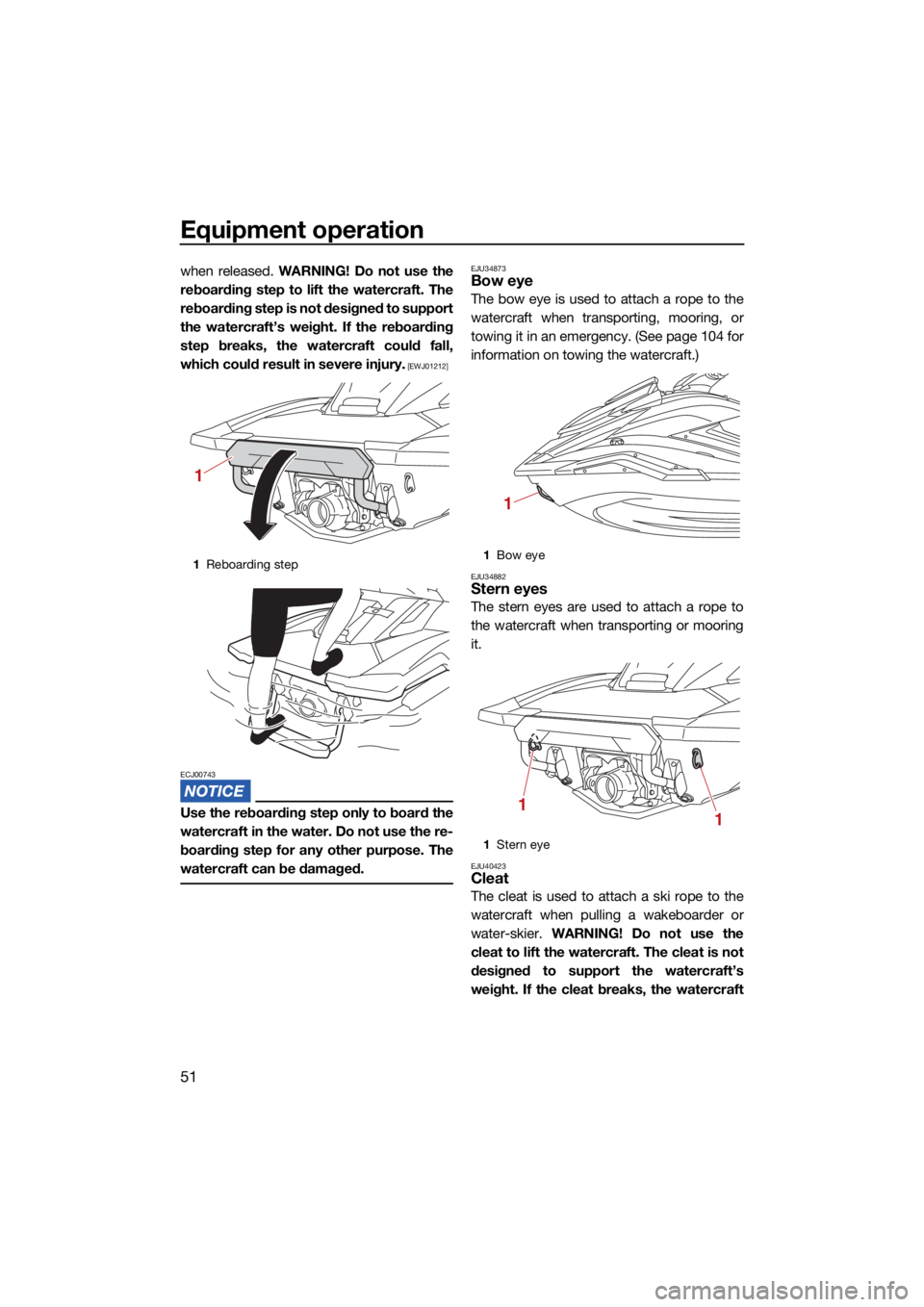
Equipment operation
51
when released. WARNING! Do not use the
reboarding step to lift the watercraft. The
reboarding step is not designed to support
the watercraft’s weight. If the reboarding
step breaks, the watercraft could fall,
which could result in severe injury.
[EWJ01212]
ECJ00743
Use the reboarding step only to board the
watercraft in the water. Do not use the re-
boarding step for any other purpose. The
watercraft can be damaged.
EJU34873Bow eye
The bow eye is used to attach a rope to the
watercraft when transporting, mooring, or
towing it in an emergency. (See page 104 for
information on towing the watercraft.)
EJU34882Stern eyes
The stern eyes are used to attach a rope to
the watercraft when transporting or mooring
it.
EJU40423Cleat
The cleat is used to attach a ski rope to the
watercraft when pulling a wakeboarder or
water-skier. WARNING! Do not use the
cleat to lift the watercraft. The cleat is not
designed to support the watercraft’s
weight. If the cleat breaks, the watercraft
1 Reboarding step
1
1Bow eye
1 Stern eye
1
11
UF3X72E0.book Page 51 Friday, May 29, 2020 10:09 AM
Page 59 of 116
![YAMAHA FX SVHO 2021 Owners Manual Equipment operation
52
could fall, which could result in severe in-
jury.
[EWJ01511]
EJU34894
Pull-up cleats (FX CRUISER SVHO /
FX LIMITED SVHO)
The pull-up cleats are used to attach a rope
to the w YAMAHA FX SVHO 2021 Owners Manual Equipment operation
52
could fall, which could result in severe in-
jury.
[EWJ01511]
EJU34894
Pull-up cleats (FX CRUISER SVHO /
FX LIMITED SVHO)
The pull-up cleats are used to attach a rope
to the w](/manual-img/51/49873/w960_49873-58.png)
Equipment operation
52
could fall, which could result in severe in-
jury.
[EWJ01511]
EJU34894
Pull-up cleats (FX CRUISER SVHO /
FX LIMITED SVHO)
The pull-up cleats are used to attach a rope
to the watercraft when mooring it.
To use a pull-up cleat, pull it up. The pull-up
cleat returns automatically to its original posi-
tion when released. WARNING! Do not use
the pull-up cleats to lift the watercraft. The
pull-up cleats are not designed to support
the watercraft’s weight. If the pull-up cleats break, the watercraft could fall,
which could result in severe injury.
[EWJ00822]
FX CRUISER SVHO
FX LIMITED SVHO
EJU35148Storage compartments
This watercraft is equipped with the following
storage compartments.
Only the securely closed watertight storage
compartment is waterproof. If you carry ob-
jects that must be kept dry, put them in a wa-
terproof bag.
Make sure that the storage compartments
are closed securely before operating the wa-
tercraft.
EJU45250Bow storage compartment
The bow storage compartment is located un-
der the hood.
1
Cleat
1
1Pull-up cleat
1 Pull-up cleat
1
1
UF3X72E0.book Page 52 Friday, May 29, 2020 10:09 AM
Page 74 of 116
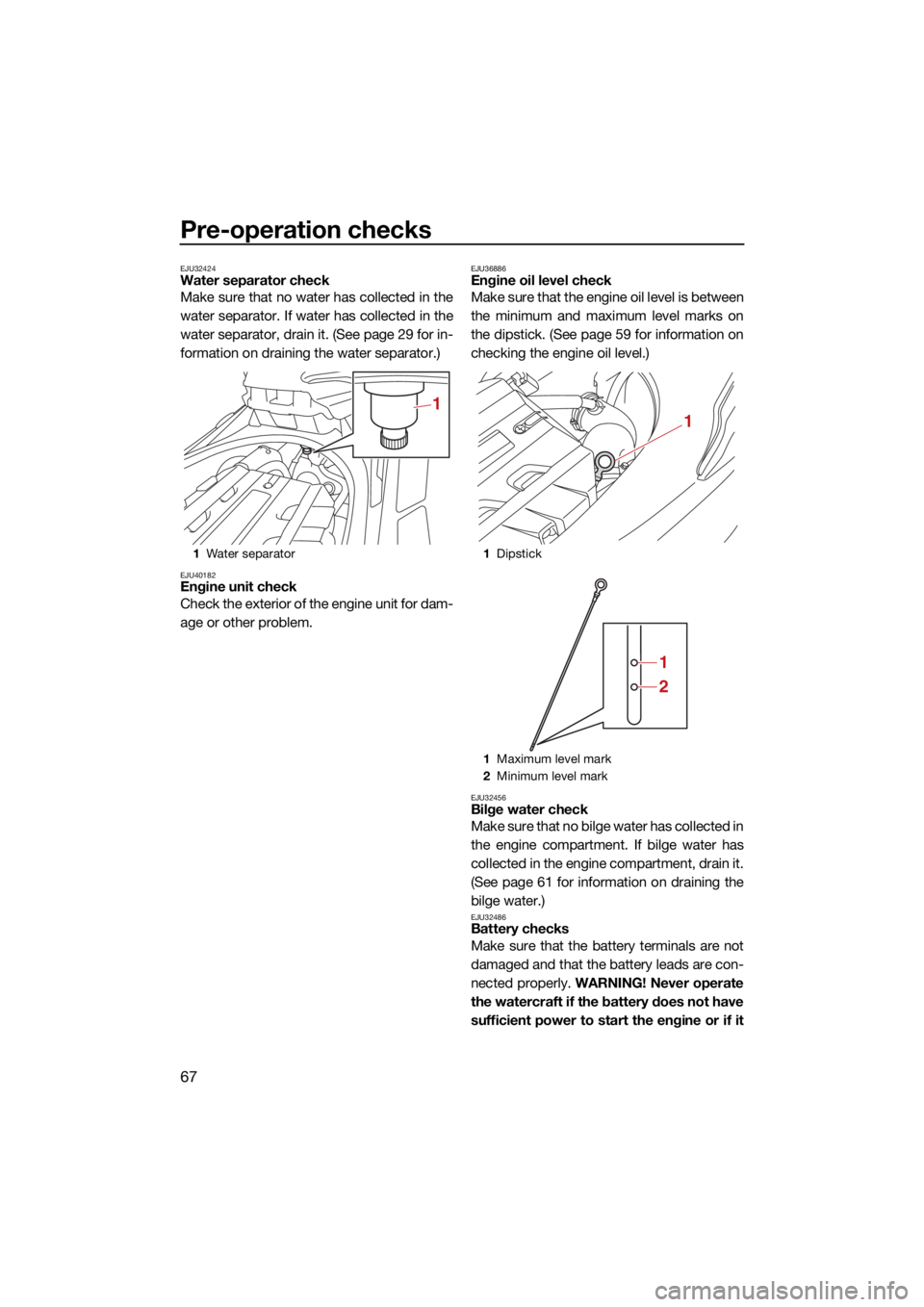
Pre-operation checks
67
EJU32424Water separator check
Make sure that no water has collected in the
water separator. If water has collected in the
water separator, drain it. (See page 29 for in-
formation on draining the water separator.)
EJU40182Engine unit check
Check the exterior of the engine unit for dam-
age or other problem.
EJU36886Engine oil level check
Make sure that the engine oil level is between
the minimum and maximum level marks on
the dipstick. (See page 59 for information on
checking the engine oil level.)
EJU32456Bilge water check
Make sure that no bilge water has collected in
the engine compartment. If bilge water has
collected in the engine compartment, drain it.
(See page 61 for information on draining the
bilge water.)
EJU32486Battery checks
Make sure that the battery terminals are not
damaged and that the battery leads are con-
nected properly. WARNING! Never operate
the watercraft if the battery does not have
sufficient power to start the engine or if it
1 Water separator
1
1Dipstick
1 Maximum level mark
2 Minimum level mark
1
1
2
UF3X72E0.book Page 67 Friday, May 29, 2020 10:09 AM
Page 76 of 116
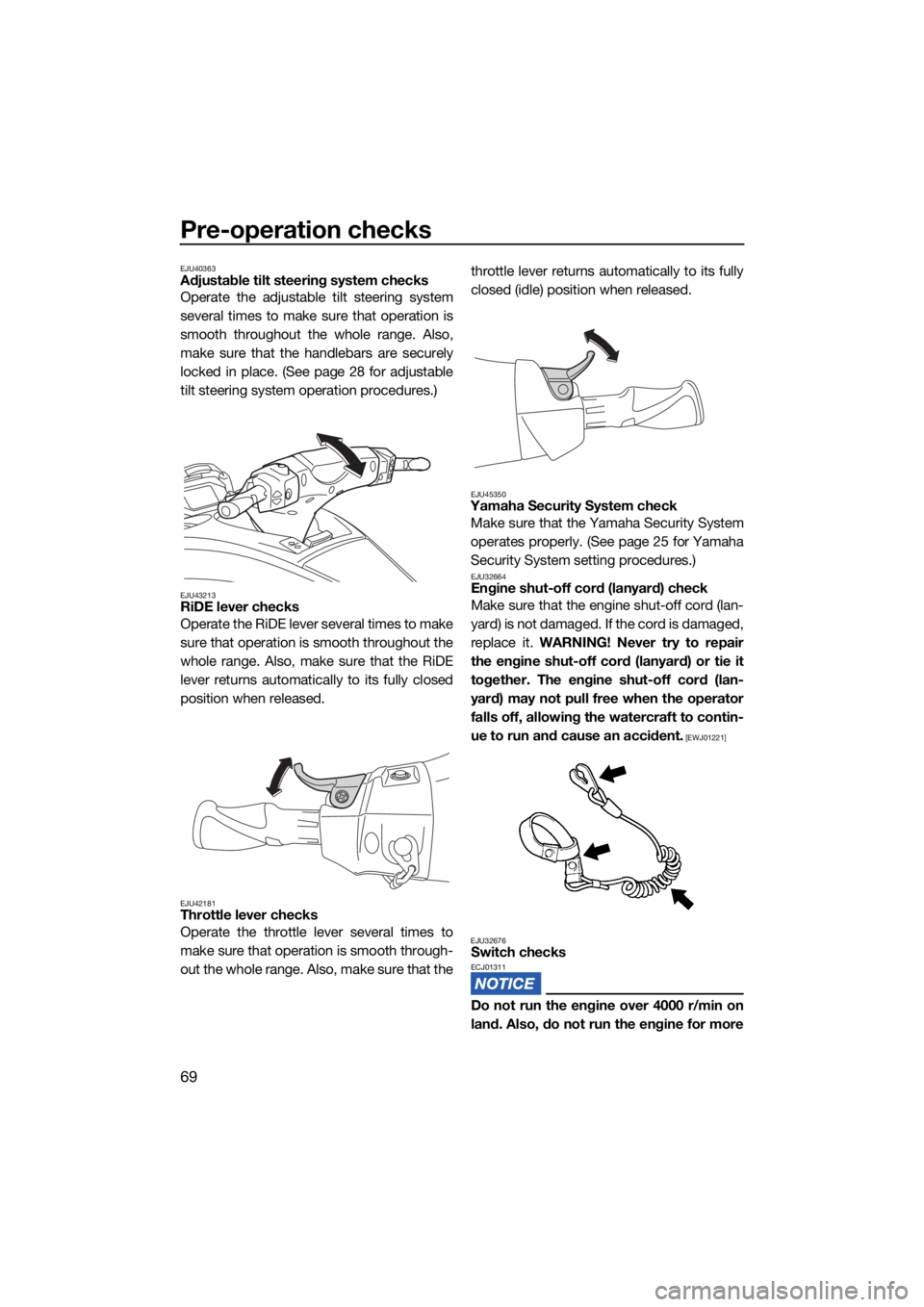
Pre-operation checks
69
EJU40363Adjustable tilt steering system checks
Operate the adjustable tilt steering system
several times to make sure that operation is
smooth throughout the whole range. Also,
make sure that the handlebars are securely
locked in place. (See page 28 for adjustable
tilt steering system operation procedures.)
EJU43213RiDE lever checks
Operate the RiDE lever several times to make
sure that operation is smooth throughout the
whole range. Also, make sure that the RiDE
lever returns automatically to its fully closed
position when released.
EJU42181Throttle lever checks
Operate the throttle lever several times to
make sure that operation is smooth through-
out the whole range. Also, make sure that thethrottle lever returns automatically to its fully
closed (idle) position when released.
EJU45350Yamaha Security System check
Make sure that the Yamaha Security System
operates properly. (See page 25 for Yamaha
Security System setting procedures.)
EJU32664Engine shut-off cord (lanyard) check
Make sure that the engine shut-off cord (lan-
yard) is not damaged. If the cord is damaged,
replace it. WARNING! Never try to repair
the engine shut-off cord (lanyard) or tie it
together. The engine shut-off cord (lan-
yard) may not pull free when the operator
falls off, allowing the watercraft to contin-
ue to run and cause an accident.
[EWJ01221]
EJU32676
Switch checksECJ01311
Do not run the engine over 4000 r/min on
land. Also, do not run the engine for more
UF3X72E0.book Page 69 Friday, May 29, 2020 10:09 AM
Page 79 of 116
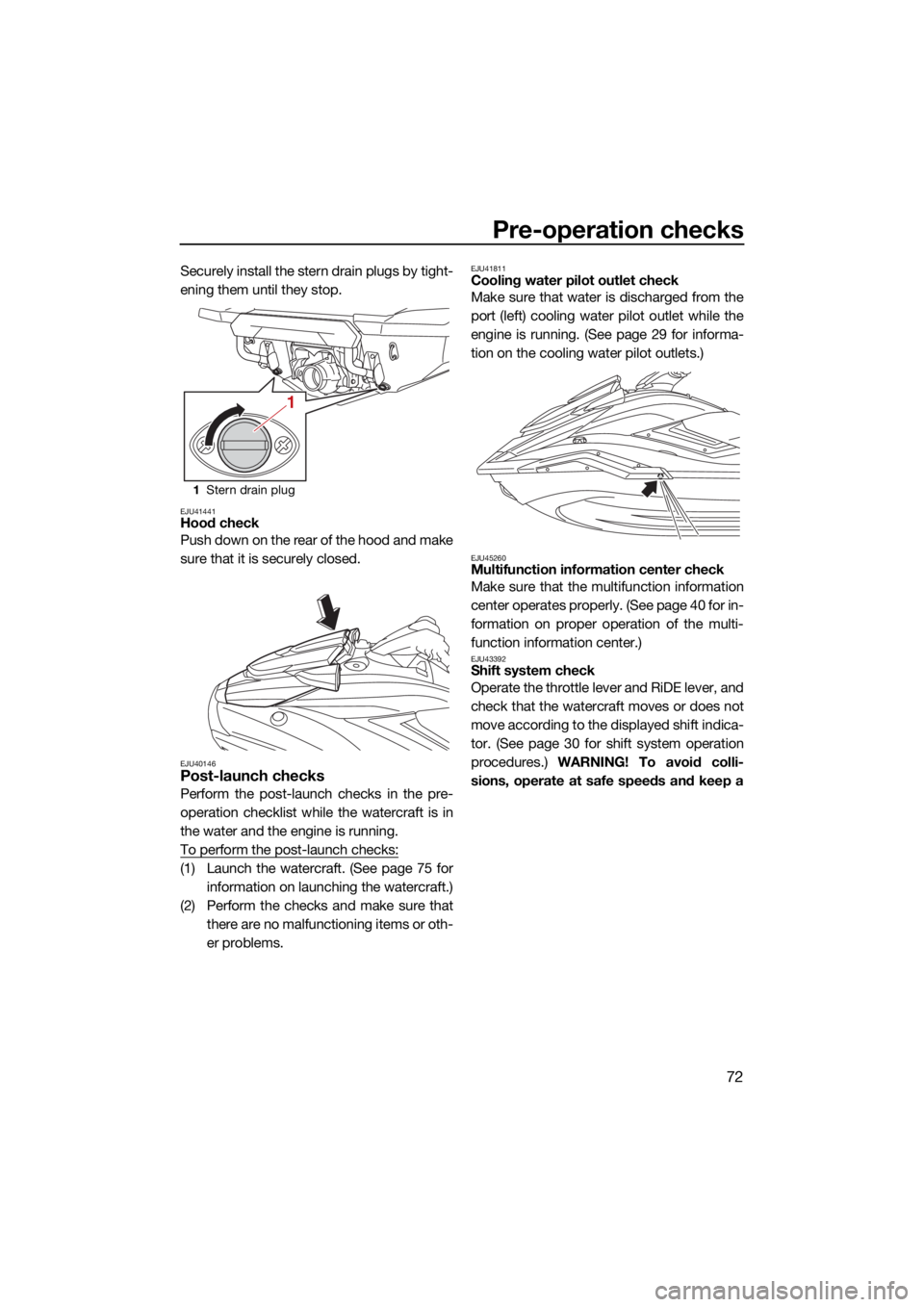
Pre-operation checks
72
Securely install the stern drain plugs by tight-
ening them until they stop.
EJU41441Hood check
Push down on the rear of the hood and make
sure that it is securely closed.
EJU40146Post-launch checks
Perform the post-launch checks in the pre-
operation checklist while the watercraft is in
the water and the engine is running.
To perform the post-launch checks:
(1) Launch the watercraft. (See page 75 forinformation on launching the watercraft.)
(2) Perform the checks and make sure that there are no malfunctioning items or oth-
er problems.
EJU41811Cooling water pilot outlet check
Make sure that water is discharged from the
port (left) cooling water pilot outlet while the
engine is running. (See page 29 for informa-
tion on the cooling water pilot outlets.)
EJU45260Multifunction information center check
Make sure that the multifunction information
center operates properly. (See page 40 for in-
formation on proper operation of the multi-
function information center.)
EJU43392Shift system check
Operate the throttle lever and RiDE lever, and
check that the watercraft moves or does not
move according to the displayed shift indica-
tor. (See page 30 for shift system operation
procedures.) WARNING! To avoid colli-
sions, operate at safe speeds and keep a
1 Stern drain plug
1
UF3X72E0.book Page 72 Friday, May 29, 2020 10:09 AM
Page 82 of 116
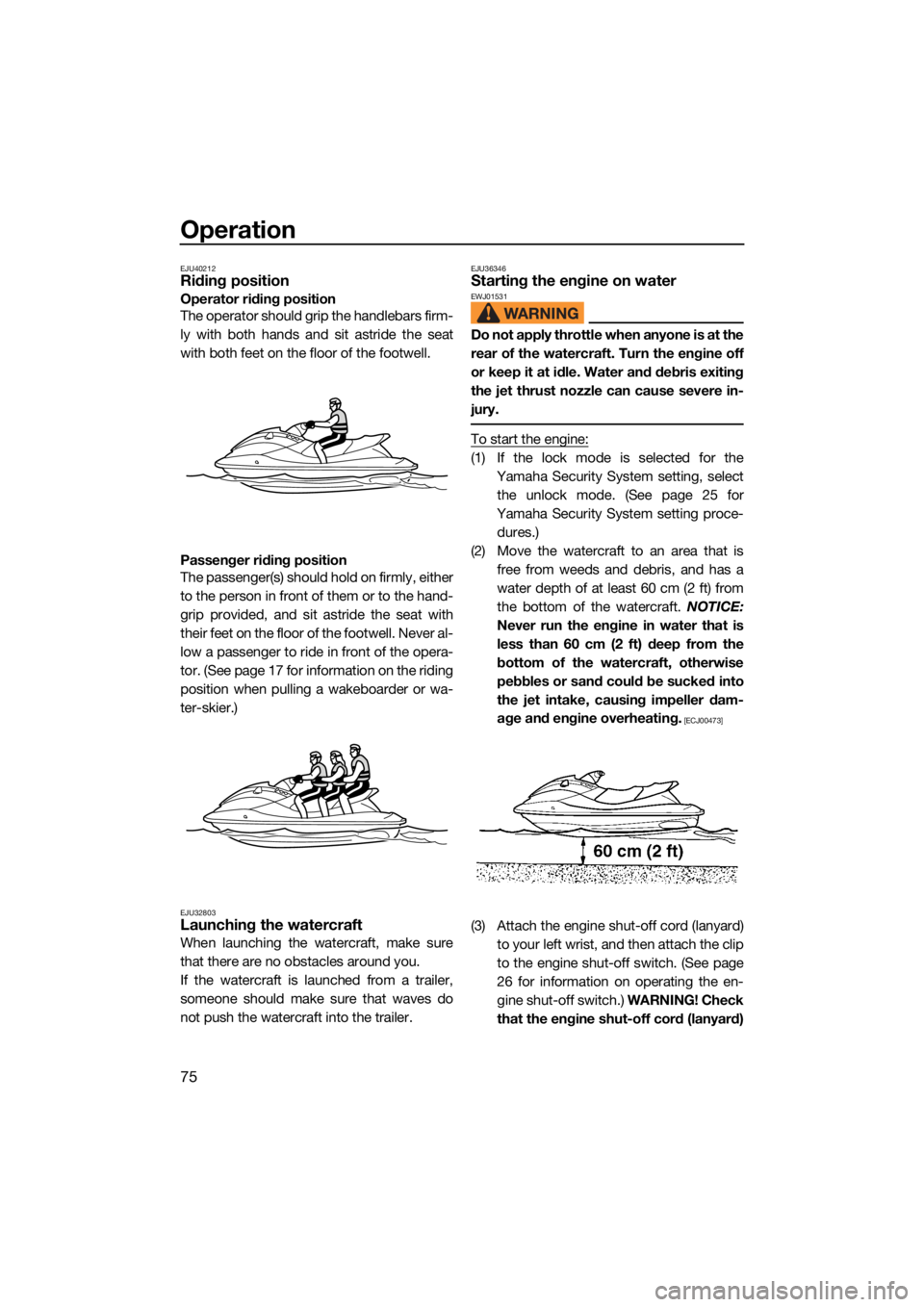
Operation
75
EJU40212Riding position
Operator riding position
The operator should grip the handlebars firm-
ly with both hands and sit astride the seat
with both feet on the floor of the footwell.
Passenger riding position
The passenger(s) should hold on firmly, either
to the person in front of them or to the hand-
grip provided, and sit astride the seat with
their feet on the floor of the footwell. Never al-
low a passenger to ride in front of the opera-
tor. (See page 17 for information on the riding
position when pulling a wakeboarder or wa-
ter-skier.)
EJU32803Launching the watercraft
When launching the watercraft, make sure
that there are no obstacles around you.
If the watercraft is launched from a trailer,
someone should make sure that waves do
not push the watercraft into the trailer.
EJU36346Starting the engine on waterEWJ01531
Do not apply throttle when anyone is at the
rear of the watercraft. Turn the engine off
or keep it at idle. Water and debris exiting
the jet thrust nozzle can cause severe in-
jury.
To start the engine:
(1) If the lock mode is selected for theYamaha Security System setting, selectthe unlock mode. (See page 25 for
Yamaha Security System setting proce- dures.)
(2) Move the watercraft to an area that is free from weeds and debris, and has a
water depth of at least 60 cm (2 ft) from
the bottom of the watercraft. NOTICE:
Never run the engine in water that is
less than 60 cm (2 ft) deep from the
bottom of the watercraft, otherwise
pebbles or sand could be sucked into
the jet intake, causing impeller dam-
age and engine overheating.
[ECJ00473]
(3) Attach the engine shut-off cord (lanyard) to your left wrist, and then attach the clip
to the engine shut-off switch. (See page
26 for information on operating the en-
gine shut-off switch.) WARNING! Check
that the engine shut-off cord (lanyard)
UF3X72E0.book Page 75 Friday, May 29, 2020 10:09 AM